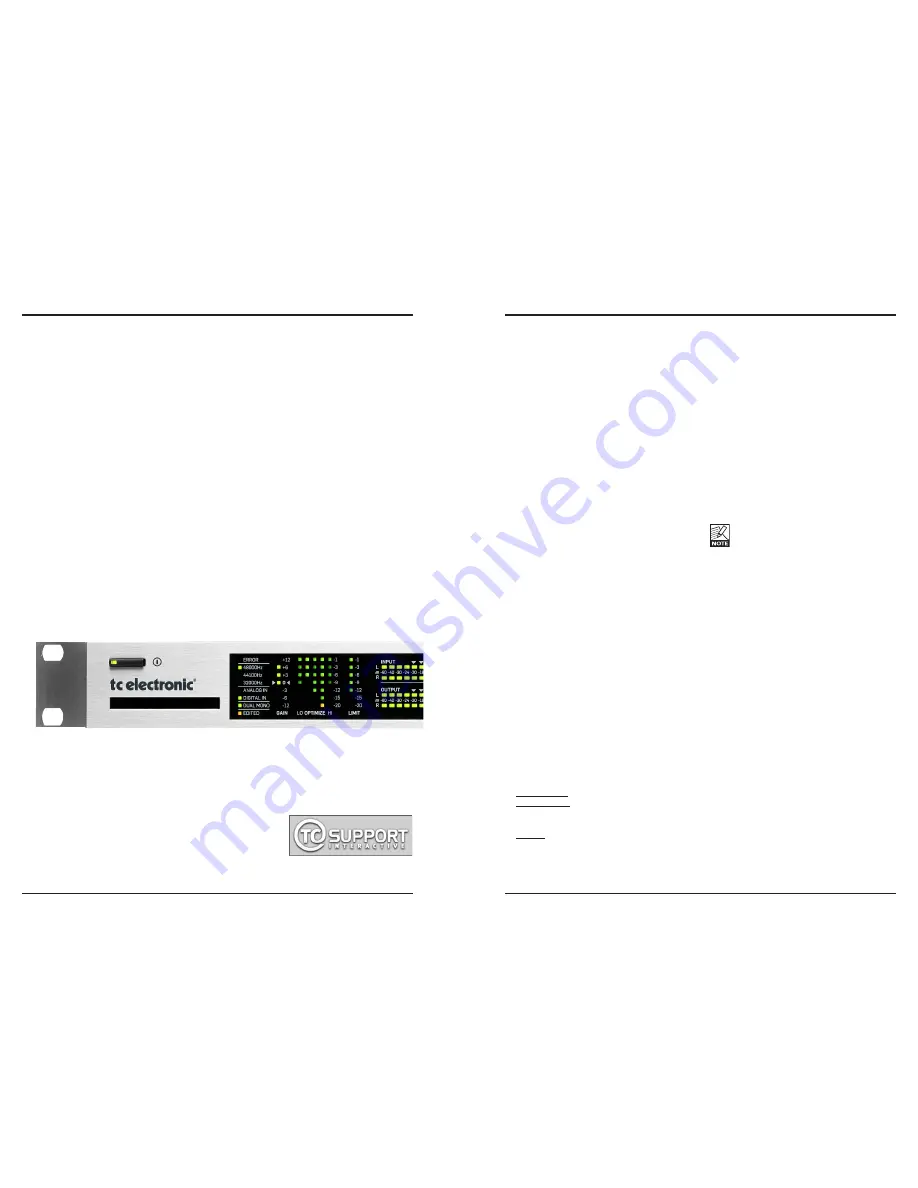
6
7
Quick Guide
Requirements
One DB2 Loudness Consistency Processor and
a computer with an Intel Pentium (or better)
processor and Windows 95, 98, NT, 2000, ME
or XP installed.
Installation of TC Icon Editor Software
Enter the CD, open it, run Setup.exe and follow
the instructions shown on-screen.
Connecting DB2
• Connect the RS232 In port of the DB2 to a
COM port on your PC. If there are several
COM ports, note to which port you have
connected the DB2.
(The supplied RS232-to-USB connector can
be used to connect the DB2 to a computer’s
USB port. However, note that where RS232
can carry signal over cable lengths of up to
200 meters, USB cable lengths should not
exceed 10 meters.)
• Programming the DB2 does not necessarily
require audio to be connected. However, if
audio connections are needed, make audio
connections according to the setup illustra-
tions in this manual.
Getting started with the TC Icon Editor
• Power up the DB2 and start the TC Icon
software on your computer.
• Go to the Setup / Devices / Port page to
select which COM (1 to 4) port you have
connected the DB2 (per default, the Editor
will look at COM ports 1 to 4 automatically).
• Go to the Setup / Devices / Select page.
Click DETECT and assign the detected DB2
to one of the eight device locations in the
right side of the display. To do so, simply
click any of the eight buttons.
• Click the ICON button in the upper left corner
to go the pages from where all local DB2
parameters are controlled.
Library Page: handles presets
System Page: handles Clock, Level trims,
Lock functions and the variable yellow LED
Threshold.
Engine: All algorithm parameters.
Cloning DB2’s using a PCMCIA card
Once a single DB2 has been set up for the
desired applications, other DB2’s in the house
can be easily cloned using a standard PCMCIA
card. In other words; it is NOT necessary to
hook up every single DB2 to a computer to set
these up.
• Insert an unprotected PCMCIA card into the
source DB2’s card slot.
• Go to the TC Icon System/Card page.
• Decide whether you wish to exclude the
System Preset that hold overall Clock
settings, Analog Trim levels, Dither, Status
Bit settings and GPI settings. To exclude the
System Preset, activate the “Exclude System
Preset” button.
Then click CREATE CLONE CARD.
ALL DATA previously stored on the card
will be destroyed when formatting the
card! If the card is write-protected, no
data can be written on the card. The
protect/unprotect switch is located at the
edge of the card.
• Remove the card and go to the target DB2
unit.
• Power off the target DB2 unit.
• Insert the card and power up using the front
panel POWER key while holding the OK key
pressed. Press UTILITY until the display
shows “C” (CLONE).
• Now press the OK key. All settings (with or
without “System Preset”, depending on your
previous selection) are now copied to the
target DB2.
QUICK START GUIDE
About this manual
The latest manual revision can always be downloaded from www.tcelectronic.com
If you have questions that are not answered by this manual, you may want to use our TC Support
Interactive site. This site is also accessed via www.tcelectronic.com
INTRODUCTION
The Tools
DB-2 offers broadcasters a wide variety of connection options to ensure simple yet comprehensive
integration into all of the most popular broadcasting systems. DB-2 can also be controlled remotely
with TC’s award-winning Icon software, allowing direct parameter control and preset switching from
any location.
Based on an immensely powerful, low latency topology, DB2 offers a host of 48 bit resolution tools
to be invoked simultaneously:
* Loudness correction as per ITU-R BS.1770-2
* 5-band Level Optimization
* Online Delay Adjustment
* Adaptive Limiting
* Emphasis Compensation
* Filtering and EQ
* Stereo Width Adjustment
The Connections
Audio I/O include 24 bit AES3-id on BNC connectors and balanced analog on XLR connectors with
analog domain gain scaling. Digital as well as analog inputs and outputs feature hardware bypass.
Remote control may be established via RS232, USB and/or GPI, and SNMP signaling is available
via the Icon application.
Содержание DB2
Страница 1: ...DB2 LOUDNESS CONSISTENCY PROCESSOR USER S MANUAL...
Страница 23: ......




















